34 countries use ActivityInfo to simplify humanitarian coordination; best practices from the biggest deployments
For over a decade, ActivityInfo has been in the heart of humanitarian response supporting coordination and response monitoring all over the world. Today, 34 countries and hundreds of organizations are using the platform to monitor various aspects related to national or regional humanitarian response and more countries are expected to join ActivityInfo in the coming year.
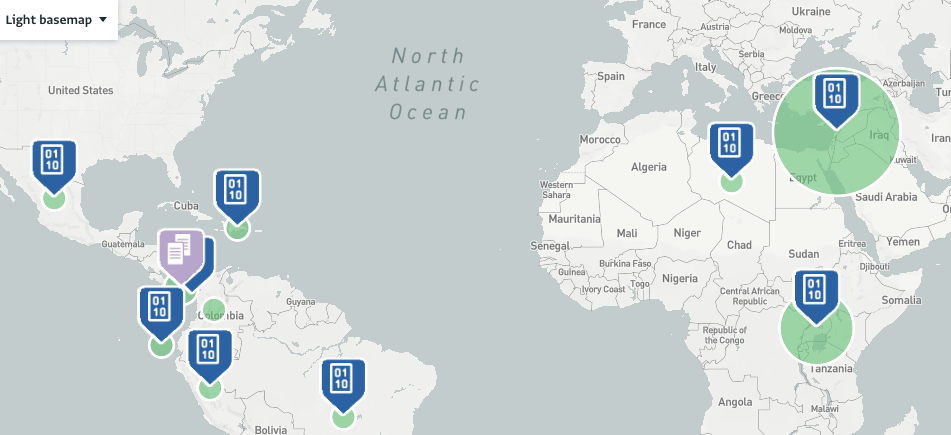
As 2022 approaches, Information Management Officers worldwide start planning for the new year reporting requirements, thinking about new or improved information management systems to put in place. They are setting fresh objectives to empower partner organizations so as to help them submit clean and quality data in a timely manner.
The team of ActivityInfo discussed in depth with the Information Management Officers of some of the biggest rollouts across three continents about the reporting processes, the ActivityInfo database structures and key lessons learnt through the year.
In this article, we are presenting some highlights from the work of information management teams from UNHCR, IOM and UNOCHA. We will explore their work on monitoring the Humanitarian Response in Lebanon, Uganda, Libya and in 17 countries working on the Response for Venezuela, hoping to provide some inspiration for information management officers who want to simplify reporting for large scale humanitarian coordination for 2022.
You can download this sheet for a summary of best practices and tips shared directly from Information Management Officers around the world and you can dive into a detailed analysis of each use case in our longer guide.
Sectors reporting monitoring for the Lebanon Crisis Response Plan
UNHCR and UNICEF in collaboration with other UN agencies bring together more than 250 partner organizations under the Lebanon Crisis Response Plan for the Syrian Refugees. The interagency is responsible for the coordination of the response and uses over 30 databases in ActivityInfo covering various aspects such as appeal, funding, monitoring, services provided and case management for 12 sectors.
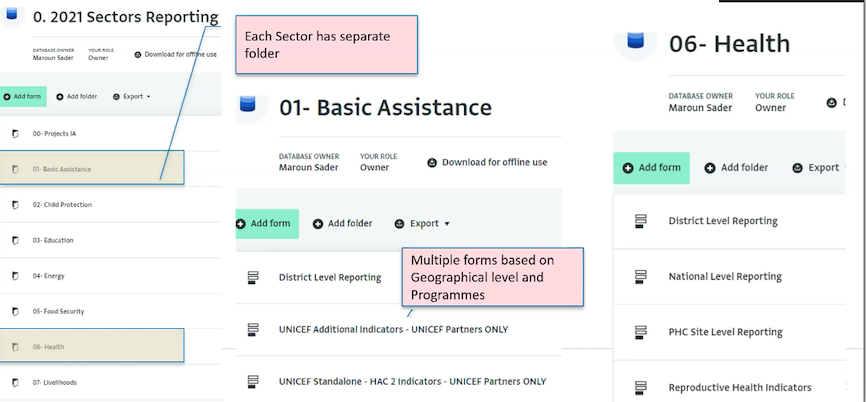
For the sectors reporting monitoring the interagency ensures that all data submitted by the 255 partner organizations involved in the Response is centralized in one place, using one ActivityInfo database and multiple folders. Using key features such as reference forms, validation rules and locks the team achieves a high level of control on the data reported and creates relationships between forms and submitted data. Then, using the ActivityInfo API, the information management team connects to Power BI and creates public information products.
Some of the tips shared by the IM team is to:
- use a single database with folders in order to bring the data of all sectors together more easily,
- link main forms to reference forms (for example for common projects),
- to use validation rules and locks to control partner reporting further and
- to share the organization's impact by leveraging the ease of use of the ActivityInfo API
We would like to thank Mr. Maroun Sader, IMO in Lebanon interagency and UNHCR for providing the information about the Sectors reporting database.
Do you want to learn more about the Sectors reporting monitoring database in Lebanon? Then, read the complete article or watch the following video:
Service mapping for the Lebanon Crisis Response Plan
Another tool created by the interagency in Lebanon with the help of ActivityInfo is the intersector service mapping for the country. Covering 4391 services, the system simplifies referrals of individuals, households or communities at-risk from one service provider to another. The interagency uses one database in ActivityInfo to bring together 161 partner organizations who report on the status of various services. The database is then combined with visualization and email software to provide a complete tool for finding, managing and updating services in Lebanon. The dashboard produced provides easy access to whoever needs to find a specific service or referral so they can easily find the organization responsible for the service and the contact information.

Using 4 separate folders under one database the interagency brings together the four field offices of the country and creates groups of information with additional folders under each field office. Partner organizations are invited to report in the forms of these folders by the respective field office.
As for tips, the interagency suggests to:
- explore the capabilities of the ActivityInfo API and the possibilities for additional tools to provide more value to colleagues and partner organizations,
- structure databases in ActivityInfo in a way that reflects the information flows from field office to partner and vice versa
We would like to thank Mr. Raffi Kouzoudjian, Information Management Officer in the Lebanon interagency for providing the information about the Service mapping database.
Do you want to learn more about the Service mapping database in Lebanon? Then, read the complete article or watch the following video:
Sector reporting coordination for the Uganda Refugee Response Plan
The regional office in UNHCR in the East, Horn of Africa and the Great Lakes region uses ActivityInfo to coordinate reporting for multiple country offices in the region such as the Kenya, South Sudan, Sudan, Rwanda, Somalia and Uganda country offices. We spoke with the IM team in the Uganda field office where ActivityInfo is used for activity tracking and response monitoring, funding tracking at project level, and case management and case tracking by partners.
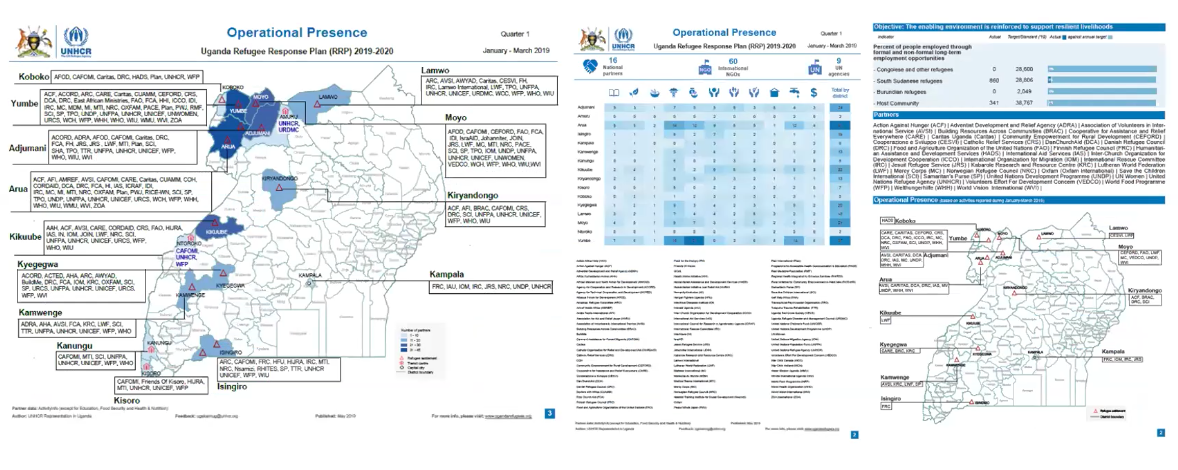
The IM team consolidates and makes all data available to partner organizations as a means to increasing transparency and encouraging participation. The database structure follows the structure of the Uganda RRP and by using key features such as validation rules and the import functionality the team saves time and decreases data cleaning needs. The IM team groups forms based on sector and reporting type (partner or sector lead) and creates separate folders for each objective which contain forms and subforms for monthly or quarterly reports on specific locations. Then, with the support of the ActivityInfo API the team combines the data using Power BI and visualizes key results using Illustrator.
As for recommendations, the country office suggests:
- try to share the costs of a subscription to ActivityInfo with the regional office,
- add a reference to ActivityInfo in partner PPAs and the RRP so as to increase leverage,
- avoid parallel tools and reporting processes,
- make sure that sector leads drive the process and senior management supports the implementation of the system,
- provide regular trainings, documentation and guides,
- allow partners to have more than one reporting focal point,
- start with national level information products and gradually increase granularity
We would like to thank Mr. Bo Hurkmans, Information Management Officer in UNHCR for providing the information about the Uganda Refugee Response Plan database. Do you want to learn more about the Uganda Refugee Response Plan? Then, read the complete article or watch the following video:
Monitoring the Libya Humanitarian Response Plan
The IM team of UNOCHA in Libya uses ActivityInfo to monitor indicators and aggregations related to the Response Plan. The team develops an internal dashboard to support data review and cleaning as well as public dashboards that offer an overview of the response and are also used for gap analysis.

Contrary to previous examples, partner organizations in the country are fewer and indicators across sectors are similar. As a result, the IM team can use a simpler database structure which simplifies data extraction and analysis. The database consists of multiple reference forms that list all the necessary, common data related to the Response (e.g. locations, partners, sectors, units, etc.). These forms are referenced in a single form with relevance rules that make sure that only relevant fields appear to each partner organization. The form collects one indicator per record and breaks it down into further disaggregations. The result is a flat table of indicator values where each row reflects one indicator value at one location and population group.
Recommendations would be:
- adapt the structure of the databases and forms to partner's capacity and the level of complexity or variety of the indicators; for a small number of similar indicators consider using one form,
- use relevance rules to show only what is relevant to the reporting partner and decrease the time they spend looking for what to report to,
- use reference forms for lists of common data that will need to be reused multiple times; this makes form updates easier as there is only one place where an update would need to be applied
We would like to thank Mr. Omar Ahmad Hasan Al Daher, Information Management Officer in UNOCHA Libya for providing the information about the Libya Humanitarian Response Plan database.
Do you want to learn more about the Libya Humanitarian Response Plan database? Then, read the complete article or watch the following video:
Monitoring the Response for Venezuela regionally and nationally
UNHCR and IOM are coordinating the reporting for the Response for Venezuela (R4V) regionally using ActivityInfo. The databases cover the reporting of 17 countries and 159 partner organizations and are developed in different languages to meet each country's specific needs. Additionally, there are 7 national platforms, (i.e. country offices hosting their own reporting databases) monitoring the activities of the partner organizations.
National IM teams, with R scripts or other tools translate the categorical values of the reported data into English, do a quality check to ensure alignment with the regional level reporting criteria and submit their data to the regional database. The regional IM team provides a data quality check tool to ensure that national data meet certain criteria before they are imported into the regional database ActivityInfo. Then, the regional IM team builds internal and external dashboards to support transparency and to help colleagues and partners maintain an overview of the Response.
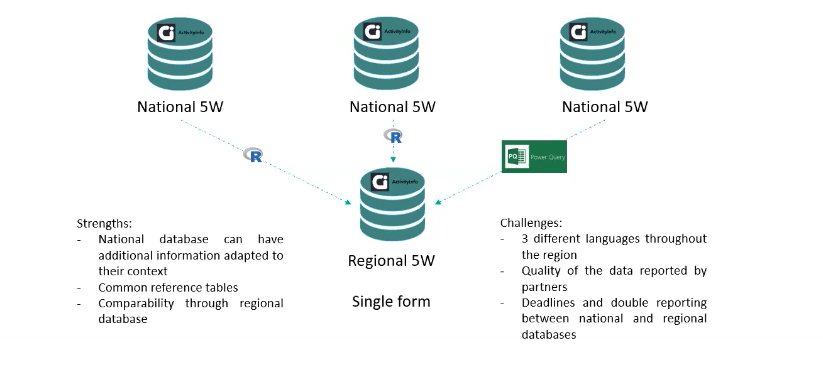
The regional 5W reporting is done in one database but there are additional databases for each country's national 5W. National IMOs have the liberty to choose the tools they prefer to collect, clean and query the national data and they can structure their ActivityInfo database in the way that best serves the country context, the number of partners and the organization's capacity. Reference forms ensure consistency among all countries and makes the data migration from the national database to the regional database easier.
Looking at some examples at the national level, Brazil uses one flat form which includes additional breakdowns than what is required from the regional reporting, due to other reporting requirements.
In the Caribbean, as there is lower capacity and fewer partner organizations, the database is structured in such a way that partners need to simply select their activity and fill in the indicator. The rest of the information can be easily selected from ready made lists.
The Response for Venezuela in Ecuador
We also took a closer look at the country office in Ecuador, where partner organizations work in 6 sectors and 3 transversals. The Information Management team collects both quantitative and qualitative data to monitor the response in the country and to support the writing of monthly situational reports on national and local level.
They also combine the ActivityInfo API with Python or R to produce dashboards. Some of the key features that support form design are the built-in geodatabase, relevance rules, the importing functionality, and reference forms. The IM team used a structure that consisted of three nested forms (forms with subforms) and will consider a new structure for 2022 to make the reporting process via importing for the partners faster.
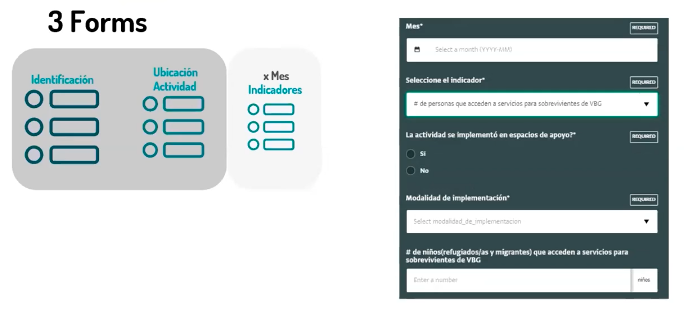
We would like to thank Mr. James Leon Dufour Information Management Officer and Mr. Francis Fayolle, Information Management Officer from UNHCR and the Regional office for the Response for Venezuela for providing the information about the regional and country databases of Brazil and the Caribbean as well as the tools used for data quality check.
We would also like to thank Mr. Jean Laurent Martin and Gabriela Urgiles Bravo, Information Management Officers in UNHCR and Mr. Jorge Cabrera Information Management Officer in IOM for providing the information about the Ecuador database.
Do you want to learn more about the Response for Venezuela databases? Then, read the complete article or watch the following videos:
Are you considering setting up a database to monitor the response in your country or region for next year? Never hesitate to contact us to discuss your needs further or to get started right away!